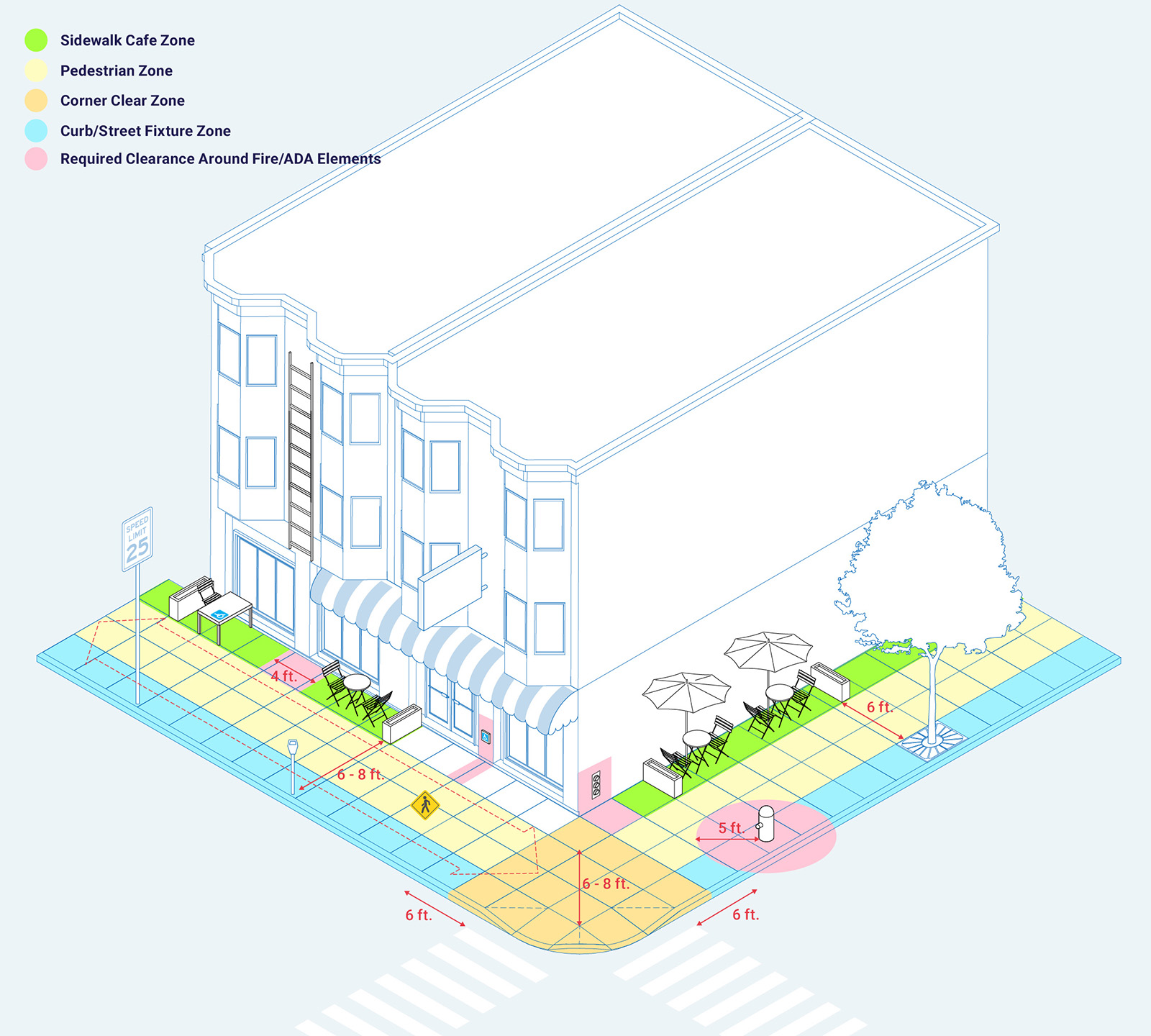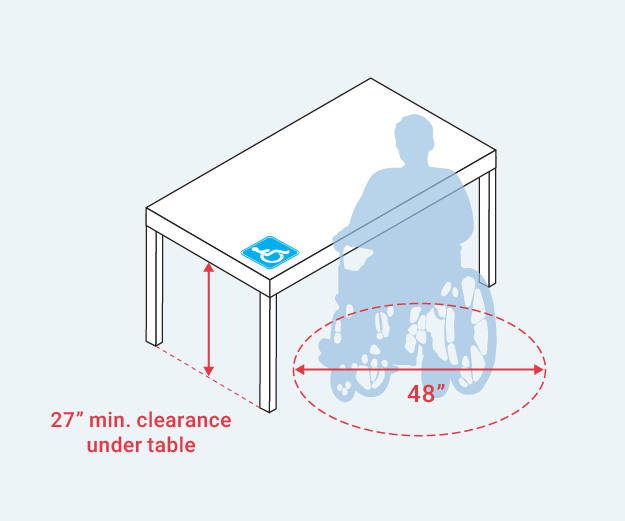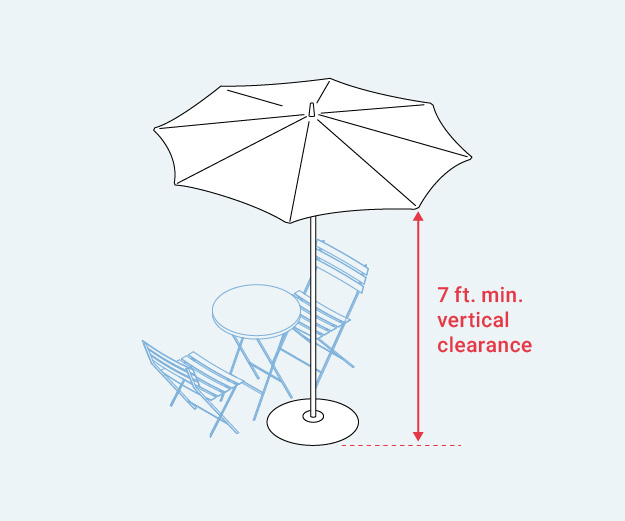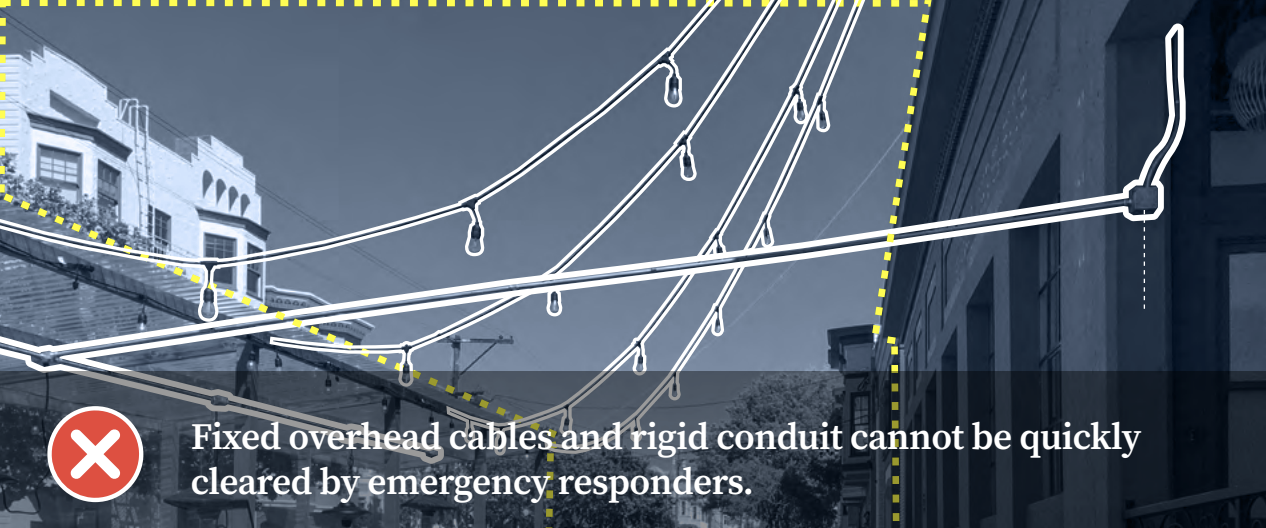INFO PAGE
Make your Shared Space accessible
Follow our accessibility rules to use the sidewalk or parking lane for your business.
If you apply to use the sidewalk or parking lane for your business, you must follow our rules to keep the space accessible. Please refer to the Shared Spaces Design Manual for full accessibility requirements for your Shared Space.

Diagram of Accessible Seating Area. Click here to enlarge.
Site Diagram of Accessible Sidewalk Seating Area
Click here to enlarge diagram
Maintain a straight, clear path of travel
Sidewalk Shared Spaces must maintain a continuous 6-8-feet minimum width pedestrian accessible route clear of obstructions at all times along the entire property frontage, including adjacent properties if applicable to their permit. Special conditions where a 6-8 feet wide path is not feasible will be reviewed on a case-by-case basis, and this exception requires approval from the Public Works Disability Access Coordinator during the registration review process.
Within the pedestrian path of travel, you must also provide an accessible route. The accessible route width is the distance from any Shared Space element to the nearest obstruction (including existing utilities, signs, poles, tree wells, etc.), landscape area, curb, or other element that restricts pedestrian path of travel. The accessible route width shall in no case be less than 6 feet. Per the SF Better Streets plan, the accessible route should not meander and should be a straight path of travel for pedestrians to navigate easily along the entire block.
You must not block:
- Curb ramps or crosswalks
- Doors
- Driveways
- Fire escapes
- Fire Department connections like a hydrant or standpipe
- Entrance access control systems
- Sidewalk next to bus stops, blue curbs, or white curbs
Use sidewalk diverters
Your business must utilize pedestrian diverters on each side of the outdoor dining area to guide pedestrians around the business operations. The objects within the sidewalk space may not extend beyond the depth of the diverters at any time. The diverters must be:
- At least 30 inches high (H), 12 inches wide (W), and 24 inches long (L)
- Solid within at least 24 inches off the ground
- Sturdy, stable, and heavy enough so they cannot tip over or be blown away by the wind
- Distinctly visible to the visually impaired with contrasting colors.
- Removable after business closure every day
- Flush with the building at approximately 90 degrees
- Free of advertising

Have an accessible table
Applicants must provide at least one (1) accessible table available for wheelchair users for each type of Shared Space. Accessible dining surfaces shall be dispersed throughout each Shared Space (at least 1 for parklets and at least 1 for sidewalk seating) for each type of seating in a functional area, in accordance with CBC Chapter 11B.
The table must:
- Be between 28 to 34 inches high
- Have at least 27 inches of space from the floor to the bottom of the table
- Provide knee clearance that extends at least 19 inches under the table
- Have a total clear floor space of 30 inches by 48 inches per seat
- Be located at least 4 feet from the nearest obstruction
- Have a label displaying the International Symbol of Accessibility
You must make sure there is an accessible route to the table (refer to platforms below).

Safe overhanging plants or umbrellas
- Umbrellas must be at least 7 feet (or 84 inches) tall. They cannot extend into an emergency access path, fire escape drop ladder landing, or beyond the approved area.
- Hanging or overhead objects must be at least 7 feet (or 84 inches) from the ground.
- Clearance under awnings and canopies shall comply with San Francisco Building Code requirements.

Hanging cords and cables
Cable ramps are not permitted because they obstruct the path of travel for wheelchairs, walkers, etc.
- Cords or cables on the sidewalk or platform can be a tripping hazard and accessibility barrier.
- Cords and cables should be hung at least 7 feet (or 84 inches) from the ground.

Parking lane access
If you cannot meet these requirements in the sidewalk space, you must make the parking lane space accessible.
Platforms for Parklets
Provide wheelchair turning space that is at least 60 inches in diameter and located entirely within the platform. You must provide either:
- A 12- inch maximum overlap on the curb and sidewalk.
- Or A T-turn per California Building Code 11B.
You must also provide:
- A 30- by 48-inch clear floor area.
- A minimum 4-feet maneuvering clearance is required from the front edge of wheelchair seating area to the table or counter.
Your platform must:
- Be durable and in good condition
- Be flush with the sidewalk
- Allow for drainage
- Be enclosed
- Have an accessible path of travel
- Have a wheelchair turning space,
- Have a wheelchair landing
An accessible route must connect the sidewalk through the accessible entrance to the deck surface, wheelchair turning space and wheelchair seating area.
Streets with a slope that exceeds 5%
If your business gets a Shared Space permit on a street that exceeds a 5% grade, you will receive additional accessibility information with your permit.
The slope and cross-slope of accessible areas must not exceed 2%. In some cases, a platform or deck may assist in meeting slope and cross-slope accessibility requirements.
You must take the appropriate actions to be accessible and safe.